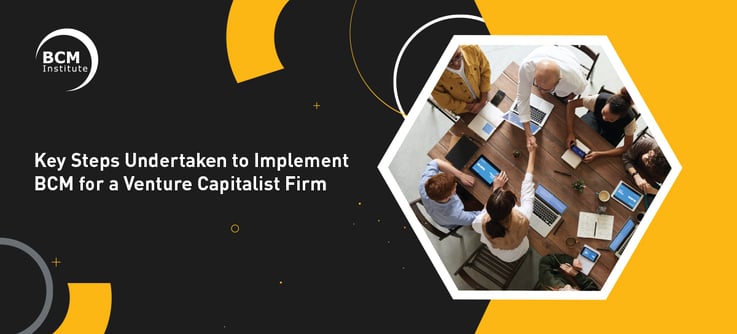What are the Key Steps Undertaken to Implement BCM for a Venture Capitalist Firm?
 Before starting your Business Continuity Management (BCM) project, one of the initial key steps is to have a good "Understanding of Your Organization: Venture Capitalist Firms" in the context of business continuity management.
Before starting your Business Continuity Management (BCM) project, one of the initial key steps is to have a good "Understanding of Your Organization: Venture Capitalist Firms" in the context of business continuity management.
What is Business Continuity Management?
 According to the ISO 22301 BCMS Standard, Business Continuity Management (Goh, 2015), or BCM, is a “Holistic management process that identifies potential threats to an organization and the impacts to business operations those threats, if realized, might cause, and which provides a framework for building organizational resilience with the capability for an effective response that safeguards the interests of its key stakeholders, reputation, brand and value-creating activities."
According to the ISO 22301 BCMS Standard, Business Continuity Management (Goh, 2015), or BCM, is a “Holistic management process that identifies potential threats to an organization and the impacts to business operations those threats, if realized, might cause, and which provides a framework for building organizational resilience with the capability for an effective response that safeguards the interests of its key stakeholders, reputation, brand and value-creating activities."
Source: ISO 22301:2019 – Societal Security – Business Continuity Management Systems - Requirements - clause 3.4
This definition can be simplified as an organization-wide discipline and a complete set of processes identifying potential impacts that threaten an organization. It provides a capability for an effective response that safeguards the interests of its major stakeholders and reputation.
What is BCM for Venture Capitalist Firms?
Business continuity management (BCM) for venture capitalist (VC) firms involves establishing strategies and processes to ensure the organization can continue its critical operations and fulfil its investment objectives, even during disruptive events or crises. VC firms handle substantial amounts of capital and investments, making it crucial to have a robust plan to mitigate risks and safeguard their operations and assets.
In the context of VC firms, BCM includes assessing and identifying potential risks that could impact the firm's ability to operate effectively. These risks may range from natural disasters, cyber-attacks, and economic downturns, to operational failures. Once identified, VC firms develop strategies and contingency plans to minimize disruptions and quickly recover from these incidents. This involves defining roles and responsibilities, implementing backup systems, establishing communication protocols, and having an offsite location to resume operations if the primary office becomes inaccessible.
A comprehensive BCM plan for VC firms also involves ensuring the safety and security of sensitive data, both financial and intellectual property. This may include data encryption, secure backup storage, and regular testing of disaster recovery and business continuity plans. By implementing effective BCM, VC firms can demonstrate their commitment to protecting their investors' interests, maintaining trust, and safeguarding the stability of their investments and the overall financial ecosystem.
BCM Planning Methodology
 Venture Capitalist Firms are vulnerable to disruptions and threats. Any incident, if not appropriately managed, can escalate to become a disaster or crisis or even cause significant injuries to employees or even death. Therefore, VC firms should be prepared for an incident before it occurs to minimize its impact should it happen.
Venture Capitalist Firms are vulnerable to disruptions and threats. Any incident, if not appropriately managed, can escalate to become a disaster or crisis or even cause significant injuries to employees or even death. Therefore, VC firms should be prepared for an incident before it occurs to minimize its impact should it happen.
One such way to prepare is to adopt a BCM Planning Methodology. Click the BCM Planning methodology picture to learn more.
The BCM planning methodology, like any other planning process, provides a framework for requirements, effort, and deliverables, each phase leading into the next in an endlessly repeating cycle. The roles and responsibilities are spelt out in the BCM framework.
The BCM Planning Methodology (Goh, 2015) is divided into various steps. The key is to divide the entire process so that it is manageable.
Risk Analysis and Review [RAR]
 A wide array of risks can be identified within the context of a Venture Capitalist Firm. One possible risk scenario is losing an office building or IT systems. The risk rating is determined based on multiplying the risk likelihood and impact. In addition to these factors, controls are often present to reduce risks. Because the Venture Capitalist Firm manages customers that are geographically dispersed over a large area, the threats should be reviewed and analysed based on location.
A wide array of risks can be identified within the context of a Venture Capitalist Firm. One possible risk scenario is losing an office building or IT systems. The risk rating is determined based on multiplying the risk likelihood and impact. In addition to these factors, controls are often present to reduce risks. Because the Venture Capitalist Firm manages customers that are geographically dispersed over a large area, the threats should be reviewed and analysed based on location.
The types of threats highlighted are as follows:
- Major disaster
- IT-related incidents
- Terror related incidents
- Disease outbreak
Business Impact Analysis [BIA]
 Business functions for a typical Venture Capitalist include Deal Sourcing and Origination; Due Diligence; Investment Evaluation and Decision-making; Deal Structuring and Negotiation; Portfolio Analysis and Modeling; Risk Assessment and Mitigation; Legal and Compliance, and many more functions as described in an earlier blog.
Business functions for a typical Venture Capitalist include Deal Sourcing and Origination; Due Diligence; Investment Evaluation and Decision-making; Deal Structuring and Negotiation; Portfolio Analysis and Modeling; Risk Assessment and Mitigation; Legal and Compliance, and many more functions as described in an earlier blog.
Click the "Understanding Your Organisation" icon to learn more about the list of business functions.
| A set of criteria is developed to guide this analysis. Business function criticality will determine the priority and urgency with which the disruption is dealt with. |  |
A set of criteria is developed to guide this analysis. Business function criticality will determine the priority and urgency with which the disruption is dealt with.
As mentioned in the earlier blog, examples of such business function should include Administration, Human Resources and Finance, which is not external facing. These functions are often centralized or even outsourced; their identification and prioritization should be considered part of the BCM scope.
Business Continuity Strategy [BCS]
 Once critical business functions are identified, it is time to develop interim recovery guidelines and procedures to allow Venture Capitalist Firms to operate between the “time of disaster” and “ready for routine business.” There is a need to develop strategies to provide for alternate facilities, and service providers and store backups of vital equipment and records in a safe place
Once critical business functions are identified, it is time to develop interim recovery guidelines and procedures to allow Venture Capitalist Firms to operate between the “time of disaster” and “ready for routine business.” There is a need to develop strategies to provide for alternate facilities, and service providers and store backups of vital equipment and records in a safe place
Plan Development [PD]
 The BC plan and its associated procedures for recovering the Venture Capitalist Firm after a crisis or disaster are documented in the development phase. This plan is based on all the essential details from the earlier business impact analysis and business continuity strategy phases.
The BC plan and its associated procedures for recovering the Venture Capitalist Firm after a crisis or disaster are documented in the development phase. This plan is based on all the essential details from the earlier business impact analysis and business continuity strategy phases.
Testing and Exercising [TE]
 Once the BC plan is documented, tests and exercises are carried out to ensure the BC plan works and its validity is proven.
Once the BC plan is documented, tests and exercises are carried out to ensure the BC plan works and its validity is proven.
The plan from the plan development phase is run through simulations, where it is ultimately graded based on criteria. If a test or exercise's results are deemed unsatisfactory, any error or omission it might have will need to be corrected.
Program Management
![BCM Planning Methodology [7] [PgM} Program Management Phase](https://no-cache.hubspot.com/cta/default/3893111/de6d4a67-78b4-4ad8-9814-2209983d0425.png) Finally, once the VC management team has approved the BC plan and the rest of the documentation, the assigned team must update and maintain the plan periodically to reflect organisational changes in the Venture Capitalist firm and prevailing environmental threats.
Finally, once the VC management team has approved the BC plan and the rest of the documentation, the assigned team must update and maintain the plan periodically to reflect organisational changes in the Venture Capitalist firm and prevailing environmental threats.
Do You Want to be BCM Competent, and Where Do I Start?
If you are a Singapore-based company or Singaporean and Permanent Resident, you can opt to receive BCM training via:
 |
 |
| WSQ BCM Course Funding: Course Code: BCM-310; BCM-320; BCM-330 | Non-WSQ BCM Course: BCM-5000 for assigned Project Manager |
![Email to Sales Team [BCM Institute]](https://no-cache.hubspot.com/cta/default/3893111/3c53daeb-2836-4843-b0e0-645baee2ab9e.png) If you are interested in setting up your BCM program via training-led implementation, please get in touch with us.
If you are interested in setting up your BCM program via training-led implementation, please get in touch with us.
References
Goh, M. H. (2015). Business Continuity Management Planning Methodology. International Journal of Disaster Recovery and Business Continuity, 6, 9–16. Retrieved from http://dx.doi.org/10.14257/ijdrbc.2015.6.02



![[ITL] [1-6] Training-led BCM Implementation: Overview](https://no-cache.hubspot.com/cta/default/3893111/f8e68a33-08ac-4d56-98f2-a8cb0c6fbe5c.png)


